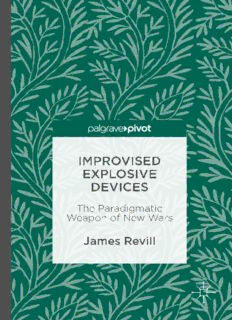
Improvised Explosive Devices : The Paradigmatic Weapon of New Wars PDF
Preview Improvised Explosive Devices : The Paradigmatic Weapon of New Wars
IMPROVISED EXPLOSIVE DEVICES The Paradigmatic Weapon of New Wars James Revill Improvised Explosive Devices James Revill Improvised Explosive Devices The Paradigmatic Weapon of New Wars James Revill University of Sussex Brighton, United Kingdom ISBN 978-3-319-33833-0 ISBN 978-3-319-33834-7 (eBook) DOI 10.1007/978-3-319-33834-7 Library of Congress Control Number: 2016947463 © The Editor(s) (if applicable) and The Author(s) 2 016 This work is subject to copyright. All rights are solely and exclusively licensed by the Publisher, whether the whole or part of the material is concerned, specifi cally the rights of translation, reprinting, reuse of illustrations, recitation, broadcasting, reproduction on microfi lms or in any other physical way, and transmission or information storage and retrieval, electronic adaptation, computer software, or by similar or dissimilar methodology now known or hereafter developed. The use of general descriptive names, registered names, trademarks, service marks, etc. in this publication does not imply, even in the absence of a specifi c statement, that such names are exempt from the relevant protective laws and regulations and therefore free for general use. The publisher, the authors and the editors are safe to assume that the advice and information in this book are believed to be true and accurate at the date of publication. Neither the pub- lisher nor the authors or the editors give a warranty, express or implied, with respect to the material contained herein or for any errors or omissions that may have been made. Printed on acid-free paper This Palgrave Macmillan imprint is published by Springer Nature The registered company is Springer International Publishing AG Switzerland A CKNOWLEDGEMENTS This case study was funded by a grant from the Economic and Social Research Council (ESRC)/Dstl Science and Security Programme. It forms part of a wider project on the “Strategic Governance of Science and Technology Pathways to Security” [ES/K011324/1] that was led by Professor Mary Kaldor and awarded jointly to the London School of Economics and Science Policy Research Unit, University of Sussex. The author would like to thank Alexander Ghionis for insightful com- ments and taking the time to read over the text and check; Roger Davies for the advice and the provision of a wealth of information on his blog “standing well back”, which is thoroughly recommended for those inter- ested in such topics; Michael Kearney for advice on legal issues; and Adrian Smith for insights into Grass Roots innovation. Additional thanks go to Caitriona McLeish, Sam Vincent, Maya Brehm, Steve Johnson, Geneviève Schméder, Paul Nightingale, Stuart Gordon, Tom McCutcheon, Peter Pringle, Kai Ilchmann, and several individuals at Dstl for providing advice on specifi c micro case studies or comments over the course of the project. This would not have been possible without the support and advice of Professors Julian Perry Robinson and Mary Kaldor, and I am very grateful to both. v C ONTENTS 1 From the Gunpowder Revolution to Dynamite Terrorism 1 Gunpowder Goes West 3 Early Post-Independence America 8 The Crimean War 9 The American Civil War 9 2 Dynamite Terrorism and the Fin de Siècle 1 9 Diffusions of Materials and Technology 20 Explosives Information 2 0 Explosives Training 21 Socio-Economic Context and the Failure of Insurrection 2 2 Extreme Irish Nationalists 2 3 Narodnaya Volya 25 Anarchists 27 3 IEDs in the Twentieth Century 3 5 Second World War 3 7 States and IEDs 39 Afghanistan and the Soviet Invasion 41 Northern Ireland and “the Troubles” 43 Middle East 46 Sri Lanka 48 vii viii CONTENTS 4 IEDs in “New Wars” 5 9 Afghanistan 60 Iraq 63 Syria 66 Use of IEDs Outside Afghanistan, Iraq, and Syria 6 7 5 The Diffusion and Adoption of IED Technology 77 Relative Advantage 79 Complexity 81 Compatibility 83 Trialability 86 Observability 87 6 Strategic Governance of IEDs 9 1 Political Interest 93 Legal Measures 94 Export Controls 9 7 Material Control and Modifi cation 9 8 Information Management 100 CIED Efforts and Forensics 1 02 Engagement 102 S tigmatisation 103 Conclusions: IED Futures from Past 111 Bibliography 1 15 Index 1 31 A A BOUT THE UTHOR James Revill is a Research Fellow with the Harvard Sussex Program, Science Policy Research Unit (SPRU), University of Sussex. Over the course of completing his PhD on the evolution of the Biological Weapons Convention with the University of Bradford, he worked as a consultant to the United Nations Institute for Disarmament Research and completed research fellowships with the Landau Network Centro Volta in Italy and the Bradford Disarmament Research Centre in the UK. Revill’s research interests focus on the interplay between science and security. ix
Description: